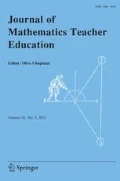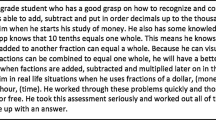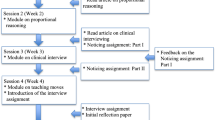Abstract
This study examined elementary and secondary prospective teachers’ (PTs’) abilities to analyze a classroom lesson in order to make claims about student thinking around specific mathematical learning goals based on relevant and revealing evidence. Previous research suggests PTs have some skills in analyzing evidence but apply them inconsistently. Our goal was to describe in more detail the strengths and weaknesses in PTs’ ability to analyze evidence of student thinking. Results indicate that PTs can make some appropriate claims about student learning in a lesson transcript, but more often make overly broad and general claims. PTs were able to support their claims with specific student work but often used poorly aligned evidence. PTs also often explicitly recognized the shortcomings of evidence from the lesson transcript, but then relied on that evidence to make claims about student thinking. Finally, PTs’ background, such as number of teacher education courses completed, does not appear to strongly influence their ability to make claims and support them with evidence, though secondary PTs were more likely to recognize the limitations of evidence than elementary PTs. These results have implications for teacher educators, pointing to the importance of designing interventions to help PTs look beyond the most visible and salient features of a lesson when analyzing student thinking.


Similar content being viewed by others
Notes
Participants could omit any question. Participants who omitted 3 or more questions were considered as not completing the study; their responses were not analyzed. Because participants could omit questions, table percentages may not always sum to 100.
We consider these subgoals one possible list; other decompositions of the learning goal are possible though these matched the responses in our data. See Morris et al. (2010).
These labels are merely meant to qualitatively describe the kind of evidence presented in the sections, not to imply that they represent categories of student responses. For example, Relevant Explanation section contains student work which is best characterized as a correct answer, but we do not claim that PTs would respond similarly to other relevant explanations.
This was deliberately left vague. We recognize that, for example, 0.351 could have been read in different ways. We were open to PTs citing this as a place where they needed more evidence, though none of them asked for this.
References
Alsawaie, O. N., & Alghazo, I. M. (2010). The effect of video-based approach on prospective teachers’ ability to analyze mathematics teaching. Journal of Mathematics Teacher Education, 13(3), 223–241.
Ball, D. L., Thames, M. H., & Phelps, G. (2008). Content knowledge for teaching: What makes it special? Journal of Teacher Education, 59(5), 389–407.
Bartell, T. G., Webel, C., Bowen, B., & Dyson, N. (2013). Prospective teacher learning: recognizing evidence of conceptual understanding. Journal of Mathematics Teacher Education, 16(1), 57–79.
Campbell, J. L., Quincy, C., Osserman, J., & Pedersen, O. K. (2013). Coding in-depth semistructured interviews: Problems of unitization and intercoder reliability and agreement. Sociological Methods and Research, 42(3), 294–320.
Chambers, C. (2019). The seven deadly sins of psychology: A manifesto for reforming the culture of scientific practice. Princeton: Princeton University Press.
Chick, H. L., Baker, M., Pham, T., and Cheng, H. (2006). Aspects of teachers’ pedagogical content knowledge for decimals. In Novotna, J., Moraova, H., Kratka, M., Stehlikova, N. (Eds.) Proceedings of the 30th annual conference of the international group for the psychology of mathematics education.
da Ponte, J. P., & Chapman, O. (2015). Prospective Mathematics Teachers’ Learning and Knowledge for Teaching. In L. English & D. Kirschner (Eds.), Handbook of International Research in Mathematics Education. New York, NY: Routledge.
Davis, E. A. and Boerst, T. (2014). Designing elementary teacher education to prepare well-started beginners (Working Paper). Retrieved from Teaching Works website: https://www.teachingworks.org/images/files/TeachingWorks_Davis_Boerst_WorkingPapers_March_2014.pdf
Ferguson, C. J., & Heene, M. (2012). A vast graveyard of undead theories: Publication bias and psychological science’s aversion to the null. Perspectives on Psychological Science, 7(6), 555–561.
Grossman, P., Hammerness, K., & McDonald, M. (2009). Redefining teaching, re-imagining teacher education. Teachers and Teaching, Theory and Practice, 15(2), 273–289.
Hiebert, J., Morris, A. K., Berk, D., & Jansen, A. (2007). Preparing teachers to learn from teaching. Journal of Teacher Education, 58(1), 47–60.
Hiebert, J., & Wearne, D. (1986). Procedures over concepts: The acquisition of decimal number knowledge. In J. Hiebert (Ed.), Conceptual and Procedural Knowledge: The Case of Mathematics. New York, NY: Routledge.
Jacobs, V. R., Lamb, L. L. C., & Philipp, R. A. (2010). Professional noticing of children’s mathematical thinking. Journal for Research in Mathematics Education, 41(2), 169–202.
Jansen, A., & Spitzer, S. M. (2009). Prospective middle school mathematics teachers’ reflective thinking skills: Descriptions of their students’ thinking and interpretations of their teaching. Journal of Mathematics Teacher Education, 12(2), 133–151.
Kazemi, E., & Franke, M. L. (2004). Teacher learning in mathematics: Using student work to promote collective inquiry. Journal of Mathematics Teacher Education, 7(3), 203–235.
Lewis, C. C., Perry, R. R., & Hurd, J. (2009). Improving mathematics instruction through lesson study: a theoretical model and North American case. Journal of Mathematics Teacher Education, 12, 285–304.
Meikle, E. (2014). Preservice teachers’ competencies to select and sequence students’ solution strategies for productive whole-class discussions. Mathematics Teacher Educator, 3(1), 27–57.
Morris, A. K. (2006). Assessing pre-service teachers’ skills for analyzing teaching. Journal of Mathematics Teacher Education, 9, 471–505.
Morris, A. K., Hiebert, J., & Spitzer, S. M. (2010). Mathematical knowledge for teaching in planning and evaluating instruction: What can preservice teachers learn? Journal for Research in Mathematics Education, 40(5), 491–529.
National Governors Association Center for Best Practices, Council of Chief State School Officers (2010). Common Core State Standards Mathematics. National Governors Association Center for Best Practices, Council of Chief State School Officers, Washington D.C.
National Research Council, and Mathematics Learning Study Committee. (2001). Adding it up: Helping children learn mathematics. Washington, D.C.: National Academies Press.
Phelps, C. M., & Spitzer, S. M. (2012). Systematically improving lessons in teacher education: What's good for prospective teachers is good for teacher educators. The Teacher Educator, 47(4), 328–347.
Rosenthal, R. (1979). The file drawer problem and tolerance for null results. Psychological Bulletin, 86(3), 638.
Sánchez-Matamoros, G., Fernández, C., & Llinares, S. (2019). Relationships among prospective secondary mathematics teachers’ skills of attending, interpreting and responding to students’ understanding. Educational Studies in Mathematics, 100(1), 83–99.
Santagata, R., & Angelici, G. (2010). Studying the impact of the lesson analysis framework on preservice teachers’ abilities to reflect on videos of classroom teaching. Journal of Teacher Education, 61(4), 339–349.
Santagata, R., & Guarino, J. (2011). Using videos to teach future teachers to learn from teaching. ZDM, 43, 133–145.
Santagata, R., & Yeh, C. (2013). Learning to teach mathematics and to analyze teaching effectiveness: Evidence from a video- and practice-based approach. Journal of Mathematics Teacher Education, 17(6), 491–514.
Sherin, M., & van Es, E. (2005). Using video to support teachers’ ability to notice classroom interactions. Journal of Technology and Teacher Education, 13(3), 475–491.
Spitzer, S. M., Phelps, C. M., Beyers, J. E. R., Johnson, D. Y., & Sieminski, E. S. (2011). Developing pre-service elementary teachers’ abilities to identify evidence of student mathematical achievement. Journal of Mathematics Teacher Education, 14(1), 67–87.
Spitzer, S. M., & Phelps-Gregory, C. M. (2017). Using mathematical learning goals to analyze teacher noticing. In E. Schack, J. Wilhelm, & M. Fisher (Eds.), Teacher noticing: Bridging and broadening perspectives, contexts, and frameworks. Cham, Switzerland: Springer.
Steinle, V., and Stacey, K. (1998). The incidence of misconceptions of decimal notation amongst students in grades 5 to 10. In Kanes, C., Goos, M., and Warren, E. (Eds.) Teaching mathematics in new times: Proceedings of the 21st annual conference of MERGA. Brisbane, AU: Griffith University.
Wasserstein, R. L., & Lazar, N. A. (2016). The ASA statement on p-values: Context, process, and purpose. The American Statistician, 70(2), 129–133.
Yeh, C., & Santagata, R. (2015). Preservice teachers’ learning to generate evidence-based hypotheses about the impact of mathematics teaching on learning. Journal of Teacher Education, 66(1), 21–34.
Acknowledgements
This work is supported in part by a grant from Central Michigan University; the ideas expressed are those of the authors alone. Initial, incomplete results of this work were originally presented at the 2016 Annual Meeting of the American Educational Research Association.
Author information
Authors and Affiliations
Corresponding author
Additional information
Publisher's Note
Springer Nature remains neutral with regard to jurisdictional claims in published maps and institutional affiliations.
Rights and permissions
About this article
Cite this article
Phelps-Gregory, C.M., Spitzer, S.M. Prospective teachers’ analysis of a mathematics lesson: examining their claims and supporting evidence. J Math Teacher Educ 24, 481–505 (2021). https://doi.org/10.1007/s10857-020-09469-x
Published:
Issue Date:
DOI: https://doi.org/10.1007/s10857-020-09469-x




